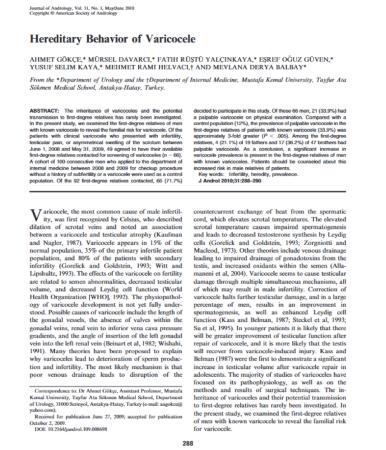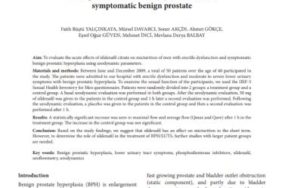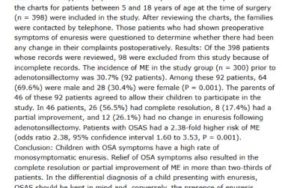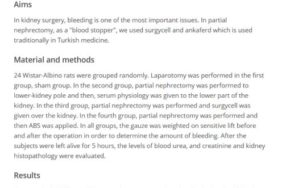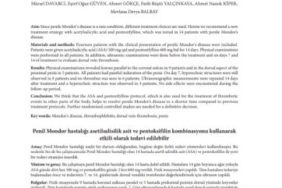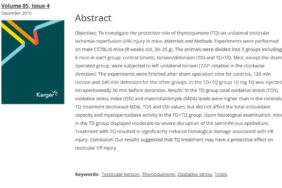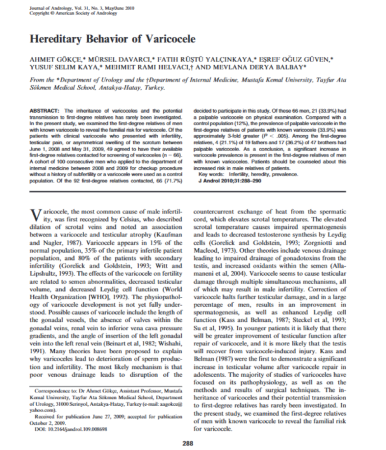
Abstract
ABSTRACT: The inheritance of varicoceles and the potential transmission to first-degree relatives has rarely been investigated. In the present study, we examined the first-degree relatives of men with known varicocele to reveal the familial risk for varicocele. Of the patients with clinical varicocele who presented with infertility, testicular pain, or asymmetrical swelling of the scrotum between June 1, 2008 and May 31, 2009, 49 agreed to have their available first-degree relatives contacted for screening of varicoceles (n = 66). A cohort of 100 consecutive men who applied to the department of internal medicine between 2008 and 2009 for checkup procedure without a history of subfertility or a varicocele were used as a control population. Of the 92 first-degree relatives contacted, 66 (71.7%) decided to participate in this study. Of these 66 men, 21 (33.9%) had a palpable varicocele on physical examination. Compared with a control population (12%), the prevalence of palpable varicocele in the first-degree relatives of patients with known varicocele (33.9%) was approximately 3-fold greater (P < .005). Among the first-degree relatives, 4 (21.1%) of 19 fathers and 17 (36.2%) of 47 brothers had palpable varicocele. As a conclusion, a significant increase in varicocele prevalence is present in the first-degree relatives of men with known varicoceles. Patients should be counseled about this increased risk in male relatives of patients.
Varicocele, the most common cause of male infertility, was first recognized by Celsius, who described dilation of scrotal veins and noted an association between a varicocele and testicular atrophy (Kaufman and Nagler, 1987). Varicocele appears in 15% of the olağan population, 35% of the primary infertile patient population, and 80% of the patients with secondary infertility (Gorelick and Goldstein, 1993; Witt and Lipshultz, 1993). The effects of the varicocele on fertility are related to semen abnormalities, decreased testicular volume, and decreased Leydig cell function (World Health Organization [WHO], 1992). The physiopathology of varicocele development is not yet fully understood. Possible causes of varicocele include the length of the gonadal vessels, the absence of valves within the gonadal veins, renal vein to inferior vena cava pressure gradients, and the angle of insertion of the left gonadal vein into the left renal vein (Beinart et al, 1982; Wishahi, 1991). Many theories have been proposed to explain why varicoceles lead to deterioration of sperm production and infertility. The most likely mechanism is that poor venous drainage leads to disruption of the countercurrent exchange of heat from the spermatic cord, which elevates scrotal temperatures. The elevated scrotal temperature causes impaired spermatogenesis and leads to decreased testosterone synthesis by Leydig cells (Gorelick and Goldstein, 1993; Zorgniotti and Macleod, 1973). Other theories include venous drainage leading to impaired drainage of gonadotoxins from the testis, and increased oxidants within the semen (Allamaneni et al, 2004). Varicocele seems to cause testicular damage through multiple simultaneous mechanisms, all of which may result in male infertility. Correction of varicocele halts further testicular damage, and in a large percentage of men, results in an improvement in spermatogenesis, as well as enhanced Leydig cell function (Kass and Belman, 1987; Steckel et al, 1993; Su et al, 1995). In younger patients it is likely that there will be greater improvement of testicular function after repair of varicocele, and it is more likely that the testis will recover from varicocele-induced injury. Kass and Belman (1987) were the first to demonstrate a significant increase in testicular volume after varicocele repair in adolescents. The majority of studies of varicoceles have focused on its pathophysiology, as well as on the methods and results of surgical techniques. The inheritance of varicoceles and their potential transmission to first-degree relatives has rarely been investigated. In the present study, we examined the first-degree relatives of men with known varicocele to reveal the familial risk for varicocele.
Materials and Methods
This study consisted of 2 phases: a retrospective review of patient charts, and prospective physical examination and collection of veri. In the first phase, all charts of patients with clinical varicocele who presented with infertility, testicular pain, or aesthetic problems between June 1, 2008, and May 31, 2009 were reviewed. Of these 113 patients, 49 (43.4%) agreed to have their available first-degree relatives contacted for screening of varicoceles. Of the 92 first-degree relatives contacted, 66 (71.7%) decided to participate in this study. In the second phase, all first-degree relatives included in this study were examined for varicocele and veri collected. All first-degree relatives were asymptomatic and had neither a history of infertility nor a prior diagnosis of a varicocele. All participants provided informed consent per Helsinki guidelines. The clinical research ethics committee of Mustafa Kemal University approved this study.
A cohort of 100 consecutive men who applied to the department of internal medicine between 2008 and 2009 for a checkup procedure without a history of subfertility or a varicocele were used as a control population. All men in the control group had undergone an equally detailed physical examination by the same urologist as the study population.
Physical examination of the scrotum and its contents was performed in all cases by the same urologist. The patients were examined in a warm room. The volume, position and consistency of the testes and epididymides were checked, and each spermatic cord was palpated in the supine and standing position, both with and without the Valsalva maneuver. Testicular volume, consistency, and the presence of varicoceles were assessed in each patient. The severity of the varicoceles was classified according to a standard grading system. Grade 1 varicoceles were small and palpated only with the Valsalva maneuver. Grade 2 varicoceles were medium and palpable only in the standing position, and grade 3 varicoceles were large and easily visualized through the scrotal skin without the Valsalva maneuver (Goldstein, 2002).
A commercially available statistics software package (SPSS for Windows v. 12.0; SPSS, Chicago, Illinois) was used to perform all statistical calculations. The χ2 test was used to compare the prevalence of varicoceles in our first-degree relative population and our control population.
Results
The demographic information of the study participants are summarized in the Table.
Table Table. . Properties of patients, first-degree relatives, and the control group
| Grading of Varicoceles | ||||||||
|---|---|---|---|---|---|---|---|---|
| No. | Varicocele, No. (%) | Unilateral, No. (%; left/right) | Bilateral, No. (%) | Total No. Varicoceles | Grade 1, No. (%) | Grade 2, No. (%) | Grade 3, No. (%) | |
| Patients | 49 | 49 (100) | 43 (87.8; 43/0) | 6 (12.2) | 55 | 3 (5.5) | 17 (30.9) | 35 (63.6) |
| First-degree relatives | 66 | 21 (33.9)a | 18 (85.7; 18/0) | 3 (14.3) | 24 | 7 (29.2) | 8 (33.3) | 9 (37.5) |
| Control | 100 | 12 (12) | 8 (72.7; 8/0) | 4 (27.2) | 16 | 2 (12.5) | 6 (37.5) | 8 (50) |
- a.P < .005 compared with control population.
The 49 primary patients with known palpable varicoceles had a mean (SD, range) age of 27.4 (5.9, 18–42) years. Of the 49 men, 43 had a unilateral left varicocele and 6 had bilateral palpable varicoceles. More than 50% of the palpable varicoceles were of grade 3.
Of the 92 first-degree relatives contacted, 66 (71.7%) decided to participate in this study. The first-degree relatives had a mean (SD, range) age of 33.8 (10.9, 16–68) years. Past medical history revealed that none of these patients had surgery for varicocele or retroperitoneal disease, which may affect gonadal veins. Of these 66 men, 21 (33.9%) had a palpable varicocele on physical examination. Among the first-degree relatives, 4 (21.1%) of 19 fathers and 17 (36.2%) of 47 brothers had palpable varicoceles. Eighteen men had a unilateral left varicocele and 3 bilaterally palpable varicoceles; 37.5% of the palpable varicoceles were of grade 3.
The 100 men used as a control population for the prevalence of varicoceles had a mean (SD, range) age of 34.1 (8.8, 21–66) years. Of these 100 men who presented without a known history of varicoceles, 12 (12%) had a palpable varicocele on physical examination. Of the 12 patients, 8 had a unilateral left varicocele and 4 bilaterally palpable varicoceles; 50% of the palpable varicoceles were of grade 3. Compared with the control population (12%), the prevalence of palpable varicocele in the first-degree relatives of patients with known varicocele (33.9%) was approximately 3-fold higher (P < .005).
Discussion
Given the results of this study, our findings indicated that there was a significant increase in the prevalence of varicocele among first-degree relatives, especially brothers, of patients with known varicocele.
Few studies have evaluated a hereditary basis for varicocele in the literature. Raman et al (2005) reported in their study that 56.5% of the first-degree relatives of patients with a known varicocele had a palpable varicocele on physical examination; that was 8-fold higher than the prevalence (6.8%) in their control population (P < .0001). In their study, they found that neither the varicocele grade nor the presence of bilateral varicoceles in their primary patient population was predictive of inheritance in the first-degree relatives (Raman et al, 2005).
Raman and colleagues included men who presented for vasectomy reversal as the control group, all of whom had prior proven fertility and might be different from the general population (Raman et al, 2005). This explains the greater difference between the first-degree relatives and controls in their study compared to ours (8-fold versus 3-fold). In the present study, the prevalence of varicoceles in the control population (12%) was close to that of the largest reported incidence of 15% in other series.
In a prospective study by Mokhtari et al (2008) they compared the prevalence of varicocele in first-degree relatives of patients with known varicocele and olağan healthy kidney donation volunteers. It was shown that 45.4% of the first-degree family members, especially the brothers (55.1%), had varicocele in the clinical examinations, which showed a significant difference with the control group (11%; P < .001). In our study, the prevalence of varicoceles in the first-degree relatives (33.9%) of patients with known varicocele and the prevalence of varicoceles in the control population (12%) had similarity to this study.
We found that 36.2% of the brothers of men with varicoceles also had asymptomatic palpable varicoceles.
The present study had few limitations. We enrolled only the available (71.7%), and not all, first-degree relatives of our patients, which might have caused some degree of selection and screening bias to the study. Additionally, sample size in this study is small. Studies on larger numbers of varicocele patients and their first-degree relatives are needed to evaluate the relation between the varicocele and the possibility of its detection in their relatives more precisely and determining its clinical importance.
Early diagnosis of varicocele is very important for preventing the progression of testis atrophy in adolescents, and men with undiagnosed varicocele are at risk of semen abnormalities, decreased testicular volume, and decreased Leydig cell function (Steeno et al, 1976; WHO, 1992). According to the results of our study and previous similar studies, we recommend that patients with varicoceles be counseled regarding the increased risk of a similar lesion in their male relatives. Despite an increased risk of varicocele that has been observed among family members of patients with varicocele, additional veri are needed to know the genetic causes of heredity and the clinical effect of such evidence on the fertility of the family members.
In conclusion, we have found a significant increase in varicocele prevalence in the first-degree relatives of men with known varicoceles. Patients should be counseled about this increased risk in male relatives of patients.

